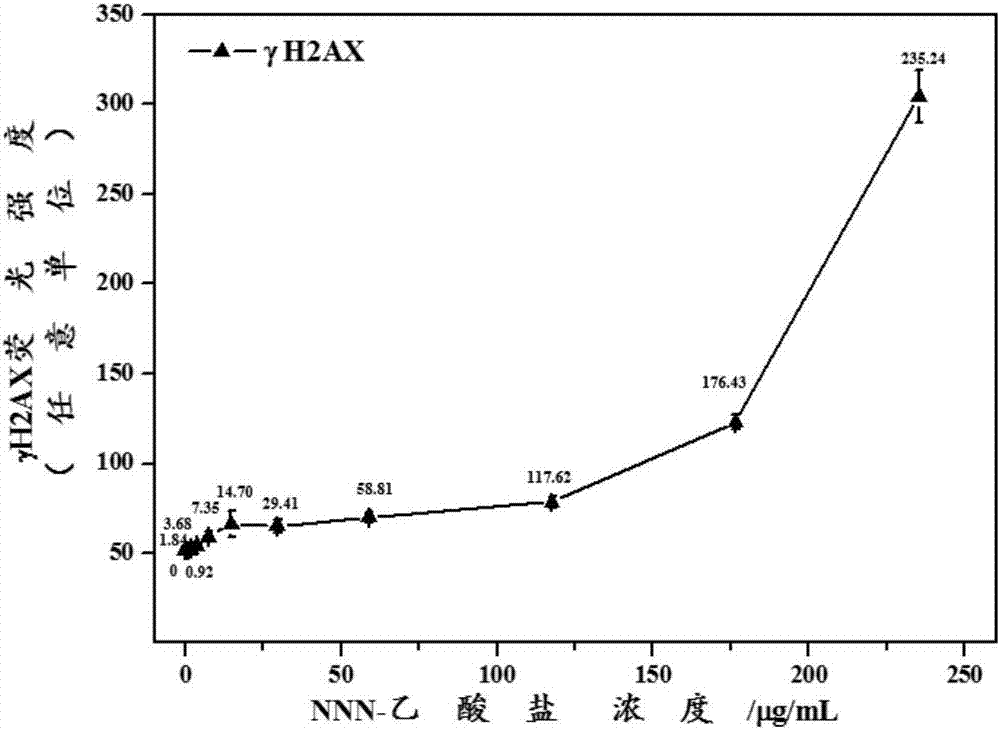Method for quantitatively analyzing cell DNA damage caused by nitrosamine or nitrosamine metabolite through high-content technology
A quantitative analysis and nitrosamine technology, applied in the direction of material analysis, material excitation analysis, material analysis through optical means, etc., can solve the problems of cumbersome operation, large error, and inability to provide intracellular fluorescence focus distribution, etc., to achieve cell The effect of small volume and small sample volume
- Summary
- Abstract
- Description
- Claims
- Application Information
AI Technical Summary
Problems solved by technology
Method used
Image
Examples
Embodiment 1
[0065] The γH2AX induced by NNN was measured after 24h exposure.
[0066] A549 cells in logarithmic growth phase were collected, planted in 96-well plates at 10,000 cells per well, in RPMI-1640 medium containing 10% FBS and 2mmoL / L L-glutamine at 37°C, 5% CO 2 Incubate in the incubator for 24h.
[0067] The cell culture fluid after culturing for 24 h was discarded, and the cell culture fluid containing 0, 15.63, 31.25, 62.5, 125, 250 and 500 μg / mL NNN (also containing 10% FBS and 2mmoL / L L-glutamine RPMI-1640 culture medium) was used as the cell poisoning solution, and the cells were continued to be cultured for 24 h.
[0068] After the poisoning, discard the cell poisoning solution, add 100 μL PBS to each well and wash twice for at least 5 minutes each time; then add 50 μL 4% paraformaldehyde solution to each well and fix at room temperature for 15 minutes; fix the cells with PBS buffer Wash twice for at least 5 min each time; then add 50 μL of 0.5% Triton-100X solution (in...
Embodiment 2
[0073] γH2AX induced by NNN-acetate exposure for 24 h was measured.
[0074] The experimental procedure was carried out as described in Example 1, the only difference was that cells were cultured with 0, 0.92, 1.84, 3.68, 7.35, 14.70, 29.41, 58.81, 117.62, 176.43 and 235.24 μg / mL NNN-acetate liquid as a cell venom.
[0075] image 3Shown is the dose-effect relationship curve of γH2AX produced by A549 cells induced by different concentrations of NNN-acetate 24 hours after exposure. It can be seen from the figure that with the increase of the concentration of NNN-acetate, the γH2AX produced in the cells induced by it shows a significant dose-dependent increase, which has a significant dose-effect relationship. When the concentration of NNN-acetate was 117.62 μg / mL, the induced γH2AX was 1.5 times higher than that of the normal group (that is, when the concentration of NNN-acetate was 0).
Embodiment 3
[0077] The γH2AX induced by NNK after 24h exposure was measured.
[0078] The experimental procedure was carried out as described in Example 1, with the only difference that cell culture solutions containing 0, 15.63, 31.25, 62.5, 125, 250 and 500 μg / mL NNK were used as cell poisoning solutions.
[0079] Figure 4 Shown is the dose-effect relationship curve of γH2AX produced by A549 cells induced by different concentrations of NNK 24 hours after exposure. It can be seen from the figure that with the increase of NNK concentration, the γH2AX produced by A549 cells has no significant change compared with the normal group (that is, when the NNK concentration is 0).
PUM
 Login to View More
Login to View More Abstract
Description
Claims
Application Information
 Login to View More
Login to View More - R&D
- Intellectual Property
- Life Sciences
- Materials
- Tech Scout
- Unparalleled Data Quality
- Higher Quality Content
- 60% Fewer Hallucinations
Browse by: Latest US Patents, China's latest patents, Technical Efficacy Thesaurus, Application Domain, Technology Topic, Popular Technical Reports.
© 2025 PatSnap. All rights reserved.Legal|Privacy policy|Modern Slavery Act Transparency Statement|Sitemap|About US| Contact US: help@patsnap.com



